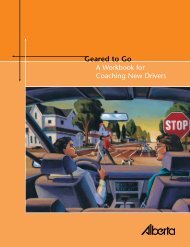Commercial driver's guide to operation, safety and licensing
Commercial driver's guide to operation, safety and licensing
Commercial driver's guide to operation, safety and licensing
You also want an ePaper? Increase the reach of your titles
YUMPU automatically turns print PDFs into web optimized ePapers that Google loves.
As a driver of persons with disabilities,<br />
you need <strong>to</strong> be aware of the unique<br />
needs of your passengers, who may<br />
range from young children <strong>to</strong> senior<br />
citizens. As their needs may be related<br />
<strong>to</strong> cognitive, developmental, sensory or<br />
physical disabilities, you will want <strong>to</strong> be<br />
familiar with ways you can provide the<br />
best cus<strong>to</strong>mer service for the different<br />
disabilities. For example, frail seniors <strong>and</strong><br />
those with reduced mobility may have<br />
health conditions that affect their balance<br />
<strong>and</strong> lead <strong>to</strong> unsteadiness or falls.<br />
It is also important <strong>to</strong> be sensitive <strong>to</strong><br />
your client’s personal space. Drivers<br />
should recognize that some people<br />
may feel uncertain if they are in a new<br />
environment.<br />
It is important <strong>to</strong> communicate with<br />
your passengers by responding <strong>to</strong> each<br />
person’s needs. As disabilities can<br />
affect an individual in different ways at<br />
different times, never assume you know<br />
an individual’s needs without first asking.<br />
Above all, be patient, courteous <strong>and</strong><br />
underst<strong>and</strong>ing of your client’s needs.<br />
General rules for<br />
communicating<br />
• Take time <strong>to</strong> discover each person’s<br />
preferred method of communicating.<br />
Whenever possible, communicate<br />
directly with the person with the<br />
disability before addressing an<br />
attendant.<br />
• When meeting a client for the first time,<br />
it is important <strong>to</strong> review the process<br />
that will be followed <strong>to</strong> transport the<br />
individual. This way the client will<br />
be reassured <strong>and</strong> underst<strong>and</strong><br />
what is happening.<br />
• When talking for any significant time <strong>to</strong><br />
those using wheelchairs or mobility aids,<br />
place yourself in front of them, at their<br />
eye level.<br />
• Offer <strong>to</strong> people who can walk<br />
assistance when it looks like it is<br />
needed, but wait until your offer is<br />
accepted before you help.<br />
• When assisting people who are visually<br />
impaired, it is important you identify<br />
yourself. Offer <strong>to</strong> help by saying<br />
something like, “You can take my arm”<br />
or “May I help/<strong>guide</strong> you”. If your help is<br />
accepted, let the person being <strong>guide</strong>d<br />
take hold of your arm.<br />
• When assisting passengers who are<br />
hearing impaired, gesture with your<br />
h<strong>and</strong> or <strong>to</strong>uch their arm lightly <strong>to</strong> get<br />
their attention.<br />
General rules for<br />
driving<br />
• Make sure passengers are properly<br />
secured in the vehicle (both seated <strong>and</strong><br />
wheelchair passengers).<br />
• Drive smoothly, avoiding sudden<br />
s<strong>to</strong>ps, starts <strong>and</strong> swerves that may<br />
cause passengers <strong>to</strong> shift or lose their<br />
balance. Ease around corners.<br />
• Maintain a comfortable temperature <strong>and</strong><br />
air circulation inside the vehicle.<br />
• Keep the noise level in the vehicle,<br />
including music or radio, <strong>to</strong> a level<br />
comfortable for your clients.<br />
72 A <strong>Commercial</strong> Driver’s Guide <strong>to</strong> Operation, Safety <strong>and</strong> Licensing




